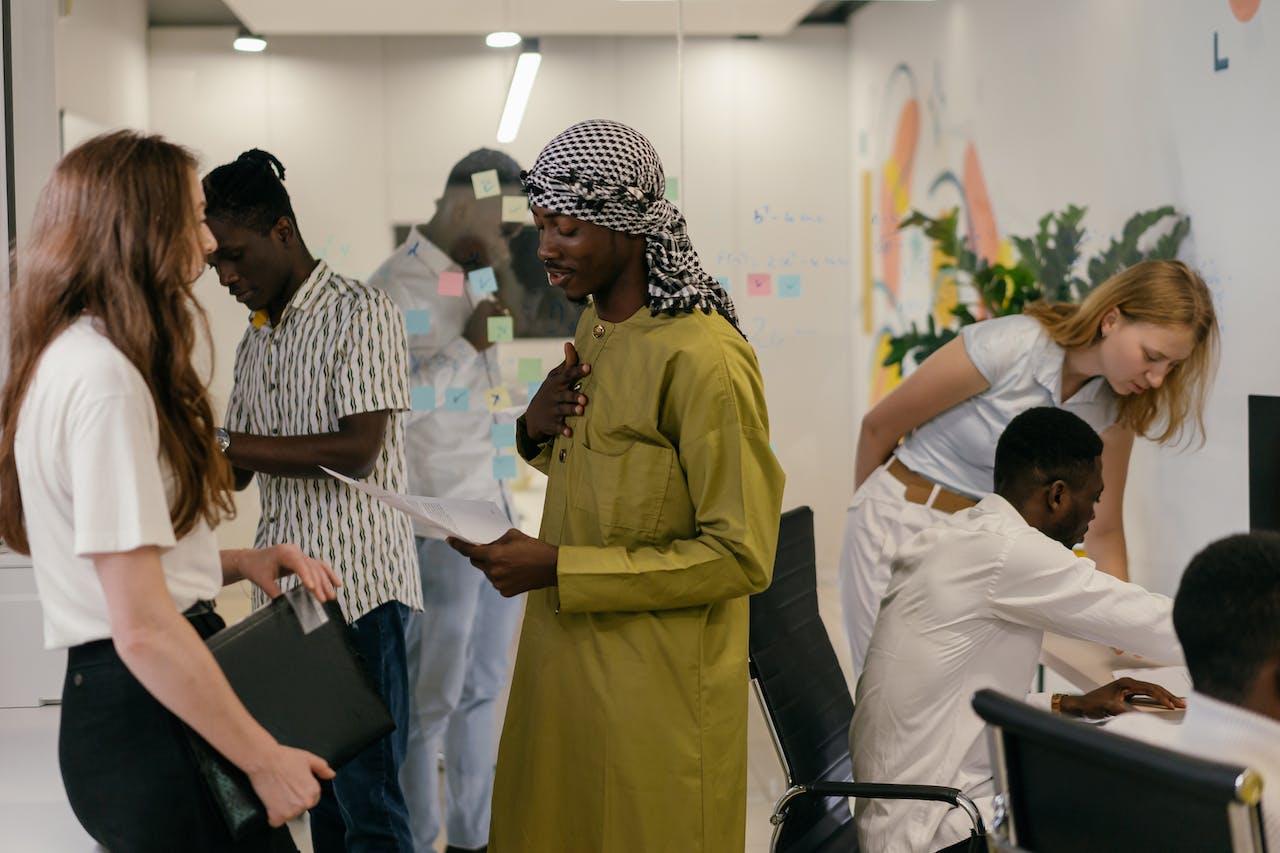Promoting Workplace Diversity and Inclusion in Kenya - Key Strategies


As businesses compete in today's global economy, diversity and inclusion initiatives have become essential to success. Embracing diversity in the workplace creates a culture of inclusion and belonging, where employees feel valued, respected, and empowered to contribute to the company.
Implementing diversity and inclusion strategies can lead to a variety of benefits, including increased creativity, improved problem-solving capabilities, and better retention rates. It can also improve your organization's reputation as a fair and responsible employer.
In this article, we will discuss key strategies that Kenyan organizations can use to promote workplace diversity and inclusion. We will highlight the benefits of diversity and inclusion best practices, including fostering inclusive work environments, implementing inclusive hiring practices, and exploring the future of workplace diversity in Kenya.
At the end of this article, you will have a better understanding of why promoting diversity and inclusion is essential in Kenyan workplaces and how it can help your business thrive. Let's begin with an overview of workplace diversity and inclusion and its importance in the Kenyan context.
Benefits of Workplace Diversity in Kenya
Creating a diverse workplace in Kenya brings many benefits to organizations. Embracing diversity and inclusion best practices in Kenya can help organizations improve their creativity, innovation, problem-solving capabilities and foster a more inclusive work environment.
Enhanced Creativity and Innovation
A diverse workplace brings together individuals from different backgrounds, experiences, and perspectives. This breadth of experiences and viewpoints can lead to more creative ideas and innovative solutions.
“Diversity is the key to creativity” - Braden Kelley
Better Problem-Solving Capabilities
A diverse workforce in Kenya can bring in different approaches to problem-solving, leading to more comprehensive and effective solutions. Individuals with diverse perspectives can offer unique solutions to long-standing problems, which can positively impact the organization's success.
Inclusion Best Practices in Kenya
Incorporating diversity and inclusion best practices in Kenyan workplaces can help in creating an inclusive work environment that values and respects individual differences.
- Establishing recruitment strategies that seek a diverse pool of candidates
- Providing training programs for employees to help them recognize their unconscious biases and promoting inclusivity in the workplace
- Offering flexibility in working hours and other benefits to accommodate diverse needs of employees
By implementing these best practices, organizations can create a positive and inclusive work culture where everyone feels valued and respected regardless of their race, gender, sexual orientation, or other differences.
Fostering Inclusive Work Environments in Kenya
Building an inclusive work environment is crucial for organizations in Kenya to thrive and succeed. It requires a concerted effort towards recognizing and valuing diversity, creating opportunities for all employees, and promoting a sense of belonging and respect.
The Importance of Diversity and Inclusion Policies
One way for organizations to create an inclusive work environment is through implementing diversity and inclusion policies. These policies set the tone for the organization's commitment to fostering a diverse and inclusive workplace. It includes guidelines for creating a culture of respect, promoting equal opportunities, and preventing discrimination.
Having a diverse workforce is just a starting point; the ultimate goal is to create a work environment where individuals feel respected, valued, and included.
The Importance of Inclusive Leadership
Inclusive leadership is critical in fostering an inclusive work environment. Leaders play a significant role in creating a culture of respect and inclusion within their organizations. They can demonstrate their commitment to diversity and inclusion by setting an example, creating opportunities for underrepresented groups, and providing training and education.
Leaders can also ensure that their organization's policies and practices support diversity and inclusion. They can identify policies and practices that may be promoting exclusion and work to eliminate them.
The Role of Diversity and Inclusion Training Programs
Diversity and inclusion training programs can also contribute significantly to creating an inclusive work environment. These programs provide employees with the knowledge and skills to build a culture of inclusion and respect.
Training programs can cover topics such as unconscious bias, cultural awareness, and communication. Employees can learn to recognize their own biases and become more empathetic to others. By fostering a positive work environment, employees can feel more confident and engaged in their work.

Fostering inclusive work environments
Fostering an inclusive work environment is an ongoing process that requires continuous effort and dedication from organizations. Through implementing diversity and inclusion policies, promoting inclusive leadership, and providing diversity and inclusion training programs, organizations can create a work environment that values diversity, respects differences and promotes equal opportunities for all employees.
Inclusive Hiring Practices in Kenyan Organizations
Building a diverse and inclusive workforce in Kenya starts with inclusive hiring practices. It is essential to recognize the importance of hiring individuals with different backgrounds, experiences, and perspectives to create a truly inclusive environment. Here are some inclusive hiring practices that Kenyan organizations can implement to attract, hire, and retain diverse talent:
Removing Bias from the Hiring Process
Unconscious bias can significantly affect the hiring process, leading to the exclusion of qualified candidates based on factors such as gender, race, ethnicity, or age. To combat this, organizations can implement measures to remove bias from the hiring process. This includes:
- Using gender-neutral job descriptions and language in job advertisements.
- Establishing clear and objective selection criteria to assess candidates' skills and qualifications.
- Conducting blind resume reviews to prevent unconscious bias from influencing the selection process.
By removing bias from the hiring process, organizations can ensure that all candidates are evaluated fairly based on their skills and abilities, leading to a more diverse and inclusive workforce.
Promoting Equal Opportunities for All Individuals
Creating an inclusive workplace means providing equal opportunities for all individuals regardless of their background. This includes:
- Offering flexible work arrangements to accommodate individuals with caregiving responsibilities or disabilities.
- Implementing equitable compensation and benefits policies that ensure all employees are paid fairly regardless of their gender, race, or other characteristics.
- Providing equal access to professional development opportunities to help employees grow and advance in their careers.
By promoting equal opportunities, organizations can attract a diverse group of candidates and create a more inclusive work environment.
Implementing Diverse Recruitment Strategies
To attract a diverse pool of candidates, organizations can implement diverse recruitment strategies. This includes:
- Partnering with community organizations and professional associations that serve underrepresented groups.
- Attending job fairs and recruitment events targeting diverse candidates.
- Using social media platforms to reach out to a broader audience.
By implementing these strategies, organizations can expand their candidate pool and attract a diverse group of applicants.
Role of Diversity Programs in Kenyan Workplaces
Diversity programs can play a vital role in attracting and retaining diverse talent in Kenyan workplaces. These programs can include:
- Employee resource groups (ERGs) that provide a platform for employees to connect, share experiences, and provide feedback to the organization.
- Diversity training programs that educate employees about the value of diversity and inclusion and how they can contribute to creating an inclusive work environment.
- Mentorship and sponsorship programs that help underrepresented employees advance in their careers.
By implementing these programs, organizations can demonstrate their commitment to diversity and inclusion, attract top talent, and create a more inclusive work environment.
"Attracting and retaining a diverse workforce requires inclusive hiring practices and ongoing commitment from organizations to create an inclusive work environment."
The Future of Workplace Diversity and Inclusion in Kenya
Workplace diversity and inclusion in Kenya has come a long way, but there is still much to be done. It is essential for organizations to recognize the importance of creating a diverse and inclusive workforce, not only for the benefit of their employees but also for the growth and success of the business.
Emerging Trends and Practices
As we look to the future, there are several emerging trends and practices that organizations can adopt to enhance workplace diversity and inclusion in Kenya. One such trend is the use of technology to remove bias from the hiring process and create diverse candidate pools. Another trend is the implementation of inclusive leadership practices, where leaders actively promote diversity and inclusion in their everyday decision-making processes.
Additionally, organizations can focus on fostering a culture of diversity and inclusion by regularly assessing their policies and practices, and making adjustments to ensure they are fully inclusive. These efforts should be supported by ongoing education and training programs that help employees understand the value of diversity and inclusion in the workplace.
The Need for Ongoing Commitment
Despite the progress that has been made, creating a truly diverse and inclusive workforce in Kenya requires ongoing commitment from organizations. This commitment should be reflected in their policies, practices, and overall culture.
Organizations should also prioritize diversity and inclusion initiatives as a strategic priority, recognizing that a diverse and inclusive workforce is essential for business success. This includes not only attracting and retaining diverse talent but also creating an environment where all employees feel valued and supported.
Final Thoughts
As Kenya continues to develop and grow, it is critical that organizations prioritize workplace diversity and inclusion. By fostering a diverse and inclusive workforce, organizations can improve their problem-solving capabilities, enhance creativity and innovation, and ultimately achieve greater business success.
With ongoing commitment and effort, we can create a brighter future for workplace diversity and inclusion in Kenya.
FAQ
What is workplace diversity and inclusion?
Workplace diversity and inclusion refers to creating a work environment that values and respects individuals from different backgrounds, cultures, abilities, and perspectives. It involves ensuring equal opportunities, fair treatment, and representation for all employees.
Why is workplace diversity and inclusion important in Kenya?
Workplace diversity and inclusion are crucial in Kenya to foster a sense of belonging, promote equality, and tap into the diverse talents and perspectives of the Kenyan workforce. It can lead to increased creativity, innovation, and better problem-solving abilities, ultimately driving business success.
What are some strategies for promoting workplace diversity and inclusion in Kenya?
Some strategies for promoting workplace diversity and inclusion in Kenya include creating inclusive leadership practices, implementing diversity and inclusion policies, conducting diversity training programs, and fostering a culture of respect and acceptance among employees.
What are the benefits of workplace diversity in Kenya?
Workplace diversity in Kenya can bring multiple benefits, such as increased employee engagement, improved decision-making processes, better customer service, enhanced reputation, and a wider range of perspectives and ideas that can lead to innovation and growth.
How can organizations create inclusive work environments in Kenya?
To create inclusive work environments in Kenya, organizations should focus on implementing inclusive leadership practices, developing diversity and inclusion policies, fostering a culture of acceptance and respect, offering diversity training programs, and providing equal opportunities for all employees.
What are some inclusive hiring practices for Kenyan organizations?
Inclusive hiring practices for Kenyan organizations include removing bias from the hiring process, promoting equal opportunities, implementing diverse recruitment strategies, conducting blind resume screenings, and training hiring managers on unconscious bias and inclusive hiring practices.
What is the future of workplace diversity and inclusion in Kenya?
The future of workplace diversity and inclusion in Kenya involves continuous efforts and ongoing commitment from organizations. This includes embracing emerging practices, trends, and technologies that enhance diversity and inclusion, as well as adapting to the changing needs and demographics of the Kenyan workforce.



